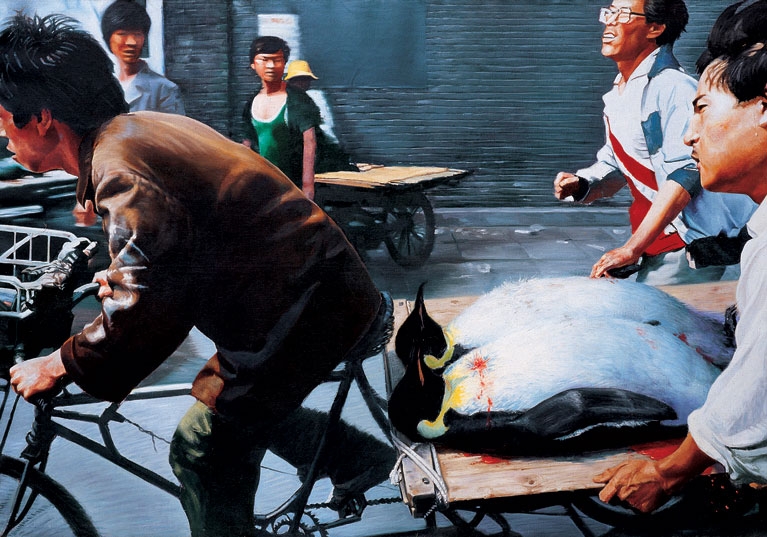Solomon R. Guggenheim Museum, New York 6 October – 7 January
Bracketed between the spectacle of cruelty of Tiananmen Square and the pageant of soft power that was the Beijing Olympics, Art and China After 1989’s complex curatorial propositions most readily coalesce around a teleological reading of China’s ascension to global power, where its art and artists alternately witness, critique, appropriate, subvert and collaborate with ever-evolving technologies of capitalist growth and governance. Qiu Zhijie’s scroll-like Map of ‘Art and China After 1989: Theater of the World’ (2017) traces this period as dark, volatile reservoirs of creativity channel into a steady, well-delineated canal of art history flowing West to East before joining the ocean of speculation and uncertainty. Organised in six chronological and thematic parts and encompassing 71 artists competing in monumentality, the exhibition chronicles radical gestures of the 1989 avant-garde; political conceptualism of the 1980s and 90s; the resurgence of ‘realism’ in response to the capitalist turn as well as accelerated and uneven development; the East Village and Post-Sense Sensibility commitment to the real and the sentient; power asymmetry and identity crisis in an ever-globalising world; and nally, the nascent empire and its discontents.
While certain conceptual strategies may feel archaic in 2017 (consider the East–West dualism in Xu Bing’s A Study of Transference (1994), one of the three works removed from the exhibition, in which two pigs copulate, the male inscribed with the artist’s self-invented Roman script and the female with Xu’s hallmark faux Chinese characters), their relevance is not entirely lost. Even though we’ve come to accept the existence of multiple modernities, what cocurator Philip Tinari describes in the show’s catalogue as the desire to ‘recover from the jet lag’ between local time and an imagined centre has all but subsided from the logic of neoliberalism. In this regard, the first half of the show is exceptionally sensitive to artists’ individual ambiguities vis-à-vis collective trajectories faced with calamity and seismic change. Beginning in mid-1980s Hangzhou and completed in mid- 90s Hamburg, Wu Shanzhuan’s performative writing and visual collage Today No Water (1986–96) stands out as an endlessly playful rehearsal and evacuation of overdetermined socialist/postsocialist semiotics.
Other microscopic yet salient connections emerge from the negotiation of multiple contexts and temporalities. Ai Weiwei and Xu Bing’s hoax work Wu Street (1993) – in which the two young émigrés hacked a prestigious Chinese art magazine by publishing the translation of a hijacked article in English, where the original artist’s name and work were replaced by Jason Jones, a fictional painter of their creation, and paintings salvaged from the East Village street – highlights the Western dominance of knowledge production over the unsuspecting Chinese, and the impact of 1980s Asian-American political consciousness on the diasporic identity politics of early émigré artists Zhang Hongtu, David Diao and Tseng Kwong Chi. Zhao Gang’s Harlem Socialism – Kitchen Talk (2002) makes an unexpected case for internationalism, while Yan Lei and Zhou Tiehai’s witty exposés of international art power’s seemingly unilateral authority over the Chinese artworld in the paintings Are You in the Exhibition Going to Germany? (1996) and There Came a Mr. Solomon to China (1994) continues to amuse and provoke.
The year 2008 marked both the official apotheosis of the artist and popularisation of the figure of artist-as-dissident – as Zhang Yimou, Ai Weiwei and Cai Guo-Qiang orchestrated China’s show of pride (‘gone is the sick man of Asia!’), Ai’s social media mass-mobilisation for his Citizen’s Investigation project (2009– 10) to uncover anthropogenic casualties of the Sichuan earthquake, which landed him in jail, was part of emergent social movements of the late 2000s enabled by new modes of information transmission and relationality. We only get an oblique peak into the quotidian,dystopian undercurrents of that period from Sarah Morris’s mesmerising lm Beijing (2008).
What happens after 2008? Gu Dexin’s Lu Xun-in ected indictment ‘WE’VE EATEN PEOPLE’ hardly speaks to the general tenor of Chinese cultural production postcrisis. It is telling that Qiu maps the last chapter of the exhibition, ‘Whose Utopia?’, as an island adrift at sea, its position inconvenient and impact yet to be determined. Among the antispectacular, yet no less monumental in scale, are Long March Project’s attempt at recuperation and praxis of leftist models of artistic production, as well as Bishan Commune’s reactivation of the Chinese intellectual tradition of rural construction in dialogue with international autonomist and anarchist traditions. In Guangdong, Liberia Borges and the Yangjiang Group, like their friends and predecessors the Big Tail Elephant Group, are radical in their emphasis on regionality, flexibility and autonomy.
In this theatrum mundi, the artists occupy a position no more privileged than their subjects. Huang Yong Ping’s Theater of the World (1993), where a Hobbesian game of all against all unfolds in a miniature panopticon, is now an empty cage still bearing traces of the lives it once held in captivity. However, the discursive framework of freedom of speech versus censorship, which has dictated much of the debate surrounding animal-rights activists’ protest and the Guggenheim’s withdrawal of key exhibits, casts this ambitious exhibition in a shadow of inopportune irony. These exhausted tropes in the Western imaginary of China – the artist as freedom fighter, the art as expression of systemic power and excess – that the curators seek to disavow or, as Hou Hanru describes it, to be ‘unthought incessantly’, come to serve as a backdrop of the liberal art institution’s anxieties over its own incapacity to address political and ethical questions as a powerful broker of culture. Challenged by black and indigenous-led protests, the Whitney’s defence of Dana Schutz and Sam Durant’s removal of his own work from the Walker Art Center tell us nothing about what ‘difficult art’ can do to the public and everything about the upending of the sanctity of the art object and the moral supremacy of individual expression. And all the better: this has enabled us to vacate the theatre.
From the Winter 2017 issue of ArtReview Asia
